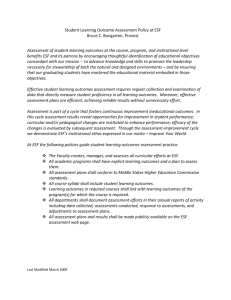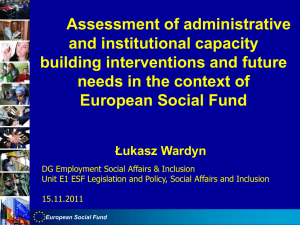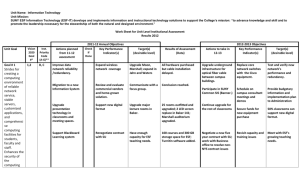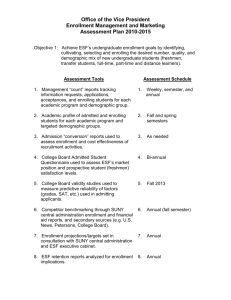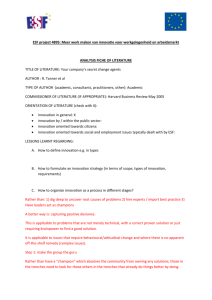What is administrative capacity?
advertisement
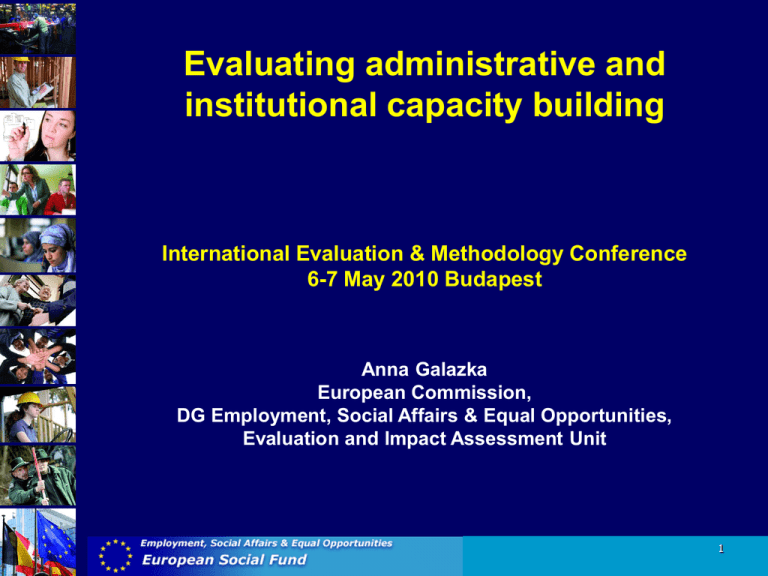
Evaluating administrative and institutional capacity building International Evaluation & Methodology Conference 6-7 May 2010 Budapest Anna Galazka European Commission, DG Employment, Social Affairs & Equal Opportunities, Evaluation and Impact Assessment Unit 1 Outline Rationale for the evaluation Purpose and evaluation questions Analytical framework and methodology 2 What is administrative capacity? “the process through which individuals, organizations and societies obtain, strengthen and maintain the capabilities to set and achieve their own development objectives over time” UNDP “the capacity to manage the complex processes and interactions that constitute a working political and economic system” World Bank 3 Rationale for the Evaluation 4 General aspects Importance of administrative capacity for the economy and for the people; Administrative and institutional reforms in the last 20 years; Role of the EU in the administrative capacity building. 5 ESF Regulation – the legal basis Strengthening institutional capacity and the efficiency of: public administrations and public services at national, regional and local level; and, where relevant, of the social partners and non-governmental organisations, with a view to reforms, better regulation and good governance especially in the economic, employment, education, social, environmental and judicial fields. 6 Purpose of the Evaluation & Evaluation Questions 7 Purpose of the evaluation To assess the relevance, effectiveness, efficiency and sustainability of the ESF 2007-13 interventions in the administrative and institutional capacity building; To provide recommendations on the priority for 2014-2020 programming period, particularly the role of the Commission. 8 Evaluation questions What was the context in which administrative and institutional capacity building interventions have taken place? What is the perceived impact of the EU preaccession and ESF support to administrative and institutional capacity building in the Member States? How could a future ESF priority on administrative and institutional capacity building look like? - What could be the role of the Commission? 9 Analytical framework and methodology 10 Methodology step by step Scoping analysis – identifying issues and interventions relevant for administrative capacity building – literature review Context analysis - inventory of administrative capacity building interventions in 10 MS national reports Mapping of the relevant ESF interventions 11 Scoping – dimensions of administrative capacity building Policy – organisational development legislation; management; cooperation. Human Resources – individual capacity development people; competences/skills; operating budget. Systems and tools - development of instruments, methods, guidelines, manuals, procedures, forms 12 Issues/ Interven tions Capacity Structures Legislation Management Human Resources Cooperat ion People Skills Systems & tools Budget Preparation Implementation Monitoring/ evaluation Policy Management Cycle 13 Context analysis – problem factors in MS administrations an inherited political culture weak structures and cooperation skills and competence gaps amongst civil servants 14 Mapping of ESF Administrative Capacity Building Activities Types of activities Countries where this activity is implemented National (N) / Regional (R) / Local (L) Main indicator used Implementation of strategic plans and/or organisational development plans Romania Hungary Lithuania Greece N, R, L N, L N, R, L N Number of administrative bodies affected by organisational development measures Activities to enhance modernisation of financial management Poland Greece N N Number of institutions receiving support for performance-based budgeting 15 Example: Challenges to Human Resource Development Strategies in National Administrations Can not be addressed by ESF interventions as presented in the OPs: Outdated strategy (RO); Lack of responsibility (RO); Lack of awareness on importance HR (RO). Can be addressed by ESF interventions as presented in the OPs: Lack of sound analysis for HRD development (BG); Lack of trained staff in HR departments (BG); Lack of integrated strategy (HU/SL/BG). 16 Difficulties for the evaluation Lack of proper indicators Most of the capacity-building projects have just started Limited transparency, dependency from political decisions 17 Next steps Case studies - selected projects Validation of findings through national focus groups Interviews with key experts from international organisations Developing recommendations Central workshop on the future role of ESF Final report planned for September 2010 18

